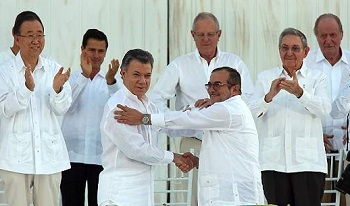Colombia has finally signed a peace deal with the oldest insurgency in the Western Hemisphere. But with the country’s criminal economies as strong as ever, the armed conflict is far from over.
Emotions ran high as Colombian President Juan Manuel Santos and the Commander-in-Chief of the Revolutionary Armed Forces of Colombia (Fuerzas Armadas Revolucionarias de Colombia – FARC) Rodrigo Londoño Echeverry, alias “Timochenko,” sealed a historic peace treaty on September 26, putting a symbolic end to the continent’s longest-running civil war.
As the world watched the ceremony unfold in the emblematic city of Cartagena, guerrilla leader Timochenko apologized to all the victims the FARC may have harmed, and vowed that the guerrillas would abandon their weapons to become a political movement.
President Santos then quoted Colombia’s national anthem in his final words to the crowd: “This is the end of the terrible night, and of the violence that has kept us in its shadow for over half a century.”
“Today I invite you all…to open our arms, our eyes, our minds, and welcome the new day. Let us open our hearts to the new dawn…the dawn of peace, the dawn of life,” the president concluded.

The signing ceremony in Cartagena, Colombia
Getting to this point was not easy. Government and guerrilla delegates — accompanied by international guarantors — sat at the negotiating table in Havana, Cuba for four long years to reach deals on agricultural reform, drug policy, fighting organized crime, the participation of the FARC and marginalized social groups in politics, transnational justice, and reparations for victims.
As the two figureheads penned their names onto the final accord at sundown in the Caribbean port city, Colombia prepared itself for its next challenge: implementing the agreements and building peace across the country.
The rest of the world also prepared. Following the signing, the European Union suspended the FARC from its list of terrorist organizations, which the guerrilla group had been on since 2002.
That same day, US Secretary of State John Kerry said that the US government would consider removing the FARC from its own list of terrorist organizations, as long as the guerrillas keep to the peace agreement.
Discussing the country’s illegal drugs issue, US Ambassador to Colombia Kevin Whitaker said that the United States accepted Colombia’s decision to suspend the aerial fumigation of illegal crops, but that both countries now needed to focus on other effective means of reducing cultivations, RCN Radio reported.
Whitaker highlighted four key strategies: increasing eradication, destroying laboratories, reducing US market demand and offering farmers alternatives to illicit crops.
InSight Crime Analysis
The FARC’s departure from the battlefield will not bring the country’s internal conflict to an end. Indeed, building a “post-conflict” Colombia promises to be just as challenging a task as the negotiations, not least due to the huge criminal bounty offered by illicit activities like illegal mining and the drug trade.
For one, other illegal armed groups, including the FARC’s guerrilla cousins in the National Liberation Army (Ejército de Liberación Nacional – ELN) as well as drug trafficking organizations, will inevitably take advantage of the FARC’s demobilization to take over their former territories. And there is a high risk that elements of the FARC — up to 30 percent, according to InSight Crime estimates — will ignore the peace deal and continue involvement in criminal activities.
Colombia’s thriving cocaine trade may well be the main driver of the country’s new criminal dynamics, and the greatest threat to future peace. Coca cultivations have more than doubled since the peace talks began, partly due to President Santos’ controversial decision to halt aerial spraying, and the country is now producing at least 650 metric tons of white powder a year.
This huge market will both fund a new generation of dissident guerrillas and fuel heightened conflict between armed groups seeking to control the illegal trade. Such a scenario poses a serious threat to the state’s mission of establishing governance in areas where the FARC has been the only de facto authority for decades. The government will need to work hard to effectively implement promised drug policy reforms if it wants to stop other groups from picking up where the FARC left off.
SEE ALSO: Coverage of Colombia’s Peace Process with the FARC
But the “post-conflict” project has already come up against more immediate obstacles. The FARC and the government appear to be divided regarding when the guerrillas’ disarmament process should begin. According to the text of the final agreement, so-called “D-Day” coincides with the signing of the pact, on September 26. Over the following eight days, the FARC should begin handing over information on its weapons and troop numbers to United Nations observers and begin moving to concentration zones, where they will officially disarm.
However, chief FARC negotiator Iván Márquez has already suggested that D-Day may be delayed until after an amnesty for guerrillas is set into law by the Constitutional Court — a process that could take weeks if not months. The importance of this date is crucial, as the more the FARC delay in concentrating troops, the more time they have to re-organize their criminal economies and redistribute their weapons.
What appears to be certain — especially if the FARC is no longer considered a terrorist organization — is that any guerrilla dissidents will lose all political status and be treated as purely criminal outfits. Government officials have already made it clear that such groups will be confronted with the full force of the military.

